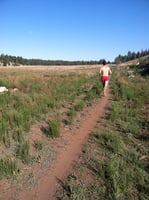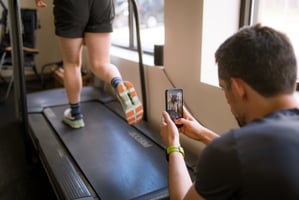We hiked a bunch growing up as kids. Living within an hour drive of some of the best hiking areas...
Boston Marathon Breakthrough: How I Learned to Embrace the Journey
(Original Post Date: 4/19/23)
I ran the Boston Marathon for the first time this past Monday, but muscle cramping from GI issues prevented me from finishing the race. The most frustrating part of marathons and ultramarathons is how a tiny error can undermine years of training. However, my biggest takeaway from this year is an enhanced mindset towards racing and running.
As a generally positive person, I try not to dwell on negativity. I hope that sharing my experience and thoughts will help other runners enhance their mindset and establish a healthier relationship with running.
The Training
I have always excelled at race distances between 8-30 minutes, but struggled with those lasting longer than 30 minutes. Thus, transitioning to marathon training over the past two years has been challenging.
When I began working with various runners as a PT, I realized that the Boston Marathon creates a strong bond among participants. Eager to experience this camaraderie, I committed to running Boston in early 2021. My plan was to run two marathons—one to qualify, and then Boston—before returning to shorter races.
Despite enjoying the Philly Marathon in November 2021 more than expected, my plan remained unchanged: one more marathon, then a break. Running Philly was just outside the qualifying window for Boston 2022. Dealing with low ferritin during my Philly training, I appreciated having until 2023 for my next marathon attempt.
My running was feeling much better by the spring, so I decided to sign up for the Maine Marathon in the fall as a way to test my fitness. Training went well throughout the summer, with a focus on my favorite interval-style workouts on the track. Longer runs improved compared to my Philly preparation, and I hoped for a decent PR at Maine. Unfortunately, I tested positive for COVID-19 six days before the race, preventing me from getting a true gauge of my fitness.
I quickly moved past the setback, as our son Calix was born less than two weeks later. After taking some time off to support Ashten's recovery and learn how to be a dad, I started my Boston training in late November. Calix's birth reordered my priorities, with running now following our business, being a supportive spouse, and embracing fatherhood.
But I didn't want running to take a back seat in my life, as it often positively influences many other aspects. I also understood the unpredictable nature of the Boston Marathon due to factors like varying weather and pacing challenges. These realizations prompted a mindset shift from outcome-oriented to process-oriented goal setting.
Instead of setting a time goal for race day and risking disappointment, I aimed to hit 4 weeks of 60 miles per week during my training cycle. I believed that achieving this would leave me fit enough to set a new personal record, and improved fitness mattered more to me than one race result. Although I didn't reach 60 miles per week 4 times, I managed 50 miles 4 times and had 6 weeks with a higher weekly mileage than my highest week before Philly.
Fueling and hydration were crucial components of my Philly training in 2021. Before that, I hadn't experienced running fast for extended periods while addressing my body's unique fueling and hydration needs.
I found a successful strategy for Philly, which also worked well in all my training runs for both Maine and Boston. I never experienced stomach issues on a long run. Though I knew it was possible, I didn't anticipate the challenges on race day.
The Race
We arrived in Boston two days before race day and met up with my parents and sister for dinner at a small burrito place. Generally, my stomach handles various foods well, so I enjoyed a tasty pork burrito without worrying. Ashten ordered the same, while the rest of my family chose different dishes.
On Sunday and Monday morning, I stuck to my usual pre-race foods, but I did notice "pre-race poops" on Sunday afternoon. In retrospect, this may have been a warning sign, as I've been racing since childhood and don't recall experiencing this so early before a race. Also in retrospect, Ashten shared with me (after the race) that she started having similar issues around the same time as me Sunday, but wanted to wait until after the race to let me know.
Race morning went smoothly, but around 10-15 minutes into the race, I sensed something was off. I saw a couple of runners heading for porta-potties around mile 3 and thought about how inconvenient it would be to face similar issues during a race. By miles 8-9, I found myself searching for a porta-potty as well. Luckily I found one just after mile 9, and my brief stop inside only cost me about a minute. For the next few miles, I felt refreshed and resumed my previous pace until reaching the half marathon mark.
At that point, I began feeling the urge to use the restroom again, with sensations coming and going intermittently. Around mile 16, I had to make a second pit stop, which took about three minutes. Not long after resuming the race, I felt early signs of muscle cramping in my left hamstring, likely due to fluid loss. Despite attempting to stick to my original fueling plan and increase fluid intake after the first pit stop, it seemed the loss was too great to overcome.
The hamstring never fully cramped, but I had to progressively slow down to avoid triggering an intense cramp. My goal shifted to jogging the rest of the way to simply finish the race. The Newton hills further drained my legs and accelerated my decline.
Seeing my parents along Heartbreak Hill gave me the motivation to keep going a bit longer, as I knew Ashten, Calix, and my sister were only a couple of miles ahead and would be worried about me.
I crested Heartbreak Hill and started descending the backside. At this point, my left hamstring started to affect my jogging stride, causing my right calf to feel crampy as well. I thought I might be able to push through a little further but didn't want to risk a significant injury that could prevent me from running this summer. Around mile 21 I decided to stop and stretch the hamstring, hoping I could resume running afterward. I managed to run for about a minute before deciding I needed to stick with walking. I considered walking the last five miles or at least until I saw Ashten around mile 22-23.
The cool temperatures and the increasing rain exacerbated the lowering of my body temperature, causing me to start shivering. Fortunately, there was a medical tent at the bottom of the hill, where I was able to hydrate, get warm, and call Ashten. We eventually met up and were lucky that the medical tent was directly across from a T-stop, making it easy for us to take the T back to Park Street, connect to the Red Line, and return to my sister's place.
On the first T, I began feeling faint, but Ashten advised me to elevate my feet, which quickly helped. This was fortunate since the next two stops had long waits without the possibility of leaving the T due to marathon traffic.
Reflections
I feel fortunate to have made the right decision to stop, to have qualified, and to have experienced 82% of the Boston Marathon. Seeing Ashten and Calix immediately confirmed that I made the right choice. I'm grateful to have things I value more than one race result and to recognize that running isn't everything.
Since dropping out, numerous people have checked in on my mental state, and I'm incredibly grateful for their support. I was surprised at how quickly I accepted the situation, which I attribute mainly to my mental shift toward prioritizing process-oriented goals. Although I didn't fully achieve my goal, my fitness level is better than it has been in years, and I'm excited to enjoy training for the next race.
I highly recommend emphasizing process goals and living in the moment, especially if you tend to hyperfocus on a single day or result. One moment in time does not define you. In working with hundreds of runners dealing with various injuries, I've observed that those who prioritize the process over the result usually achieve better long-term outcomes, both with race results but also with their overall health, relationships, and well-being. Many former competitive runners struggle to transition from results-oriented to process-oriented thinking, and this often leads them to abandon running altogether or to always have an unhealthy relationship with racing.
Will I return to the Boston Marathon? Eventually, yes, but I haven't decided if it will be soon or not. I didn't switch from "race mode" to "try to have fun mode" until after the halfway point, and by then, my primary focus was on running in a way that wouldn't worsen my hamstring. I didn't want to expend too much energy early on by getting caught up in the race excitement. It would be wonderful to run the marathon again, fully appreciating and enjoying the atmosphere—which was my original plan for the second half of the race had things gone smoothly.
Nevertheless, the race day turnout along the entire course was incredible. There were hardly any stretches without spectators, which is what I had heard about the race but thought it could have been an exaggeration. The city's energy was palpable throughout the weekend, but I'm not sure I'll fully understand it until I someday make the iconic turns in the race—a right onto Hereford and a left onto Boylston—to finally cross the finish line. For now I’ll be happy getting back into the process of training with the awesome running groups throughout Southern Maine and enjoying running for more reasons than just performance.




